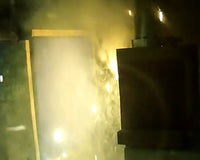IEC 61482 is a safety standard that sets the requirements for ensuring protective clothing protects the wearer against the thermal hazards of an electric arc. This standard ensures protective clothing can withstand the heat, flames, and molten metal that can come from electric arcs, ensuring the wearer stays safe when working around electricity.
The IEC 61482 standard
IEC 61482 is a safety standard developed by the International Electrotechnical Commission (IEC) to provide the guidelines and requirements for protective clothing design to protect against the thermal hazards associated with an Electric Arc.
This standard provides eligibility to sell protective clothing meant for Electric Arc flash protection within the European Union (EU).
IEC 61482 covers aspects such as the materials used in the clothing, design features, performance requirements, testing methods, and labelling requirements to ensure that the protective clothing offers the wearer suitable protection against the thermal hazards of electric arcs.
Electric Arcs and Arc Flash explained
An Electric Arc is a visible discharge of electricity that happens when current flows through the air between two conductive objects. This phenomenon can happen in a variety of situations, including when electrical equipment is poorly maintained, conductors are damaged, or there is a fault in the electrical system.
Arc Flash is a sudden release of electric energy, making it a type of electrical explosion. Arch Flashes produce intense heat, light, noise, and force which can result in serious injuries, burns, or fatalities to nearby individuals.
Both electric arcs and arc flashes can be especially hazardous to anyone in the nearby vicinity. IEC 61482 certified protective clothing offers protection against the thermal hazards of electric arc for anyone working in industries where electrical work is performed. As such, compliance with IEC 61482 is essential for ensuring the safety of workers exposed to electric arc hazards.
IEC 61482 requirements and test methods
IEC 61482 sets several requirements and test methods to ensure protective clothing effectively protects the wearer against the thermal hazards of electric arcs.
It is important to note that the IEC 61482 standard requirements are significantly different to the EN ISO 11612 standard for flame retardant clothing. These two standards are not comparable. While EN ISO 11612 certified garments offer protection against heat and flame, this standard does not account for electric arc or arc flash protection.
IEC 61482 includes testing of more rigorous parameters specific to the thermal hazards related to electric arc. This is performed through the following test methods:
- Open Arc Test Method as per IEC 61482-1-1
- Box Test Method as per IEC 61482-1-2
The pictogram for IEC 61482 certified garments was updated in 2019 to better reflect the hazards protected against.
Underneath the pictogram, the class to which the clothing complies will be specified such as “APC=1” or “APC=2” which determines whether it offers Arc Protection Class 1 or 2.
IEC 61482 requirements and test methods
The IEC 61482-1-2: Box Test Method is based on the original European test method, as described in ENV 50354. This ‘box arc’ test method measures heat transfer to classify the garment as Arc Protection Class (APC) 1 or APC 2, with APC 2 offering the highest level of protection.
|
Arc Protection Class |
Heat transfer protection |
|
APC 1 |
4kA |
|
APC 2 |
7kA |
The latest version of this test method is IEC 61482-1-2:2018, which replaced the 2009 version in 2018.
IEC 61482-1-2: Box Test Method
The IEC 61482-1-2: Box Test Method is based on the original European test method, as described in ENV 50354. This ‘box arc’ test method measures heat transfer to classify the garment as Arc Protection Class (APC) 1 or APC 2, with APC 2 offering the highest level of protection.
IEC 61482-1-1: Open Arc Test Method
The latest version of the open Arc test method under IEC 61582 was released in 2019, resulting in the standard name of IEC 61482-1-1:2019. This replaces the earlier version of IEC 61482-1-1:2002 and introduces a new protection rating called the incident energy limit value (ELIM).
The ‘open arc’ test method is used to determine the Arc Thermal Protection Value (ATPV), Energy Breakopen Threshold (EBT), or the ELIM of the clothing material, based on the Stoll Curve. As such, the open arc test method measures the calorific value of the heat energy produced.
|
Measurement Value |
Description |
|
Arc thermal protection value (ATPV) |
ATPV is the maximum thermal energy any arc flash protective clothing can withstand until the wearer would have a 50% probability of getting second-degree burns |
|
Energy breakopen threshold (EBT50) |
EBT50 value is the incident energy level at which there is a 50% probability that a protective garment would break open. Breakopen is defined as an open area of at least 1.6 cm² after exposure |
|
Incident energy limit value (ELIM) |
ELIM represents the maximum incident energy that a protective clothing can prevent against in a hazardous situation with 0% probability of enough energy getting through the garment to cause a second-degree burn. |
ATPV, EBT and ELIM can be evaluated in a single assessment through an open arc test, as per IEC 61482-1-1.
If the material has more thermal insulation resistance to heat than the arc tensile strength, it will breakopen first providing an EBT50 value. If the material will allow burns before it breaks open, the ATPV value is provided. The lowest value is the one that is used in the marking of the textile material. The higher the value of ATPV or EBT50, the better the performance level of the textile material.
In comparison to the IEC 61482-1-2 Box test, this testing method is not restricted to the specific energy level tests of 4kA & 7kA. This, as the name suggests, is an open evaluation of the textile material at unlimited energy levels to check their sustainability in case of electric arc accidents in the industries.
In May 2019, the ELIM rating was introduced in addition to ATPV and EBT50. ELIM was introduced because the opinion of the EU was that IEC 61482-1-1 could be in conflict with EU safety directives.
According to the directives, no standard should have any chance of imposing harm to a worker. ATPV and EBT both impose a 50% probability that a worker will sustain second-degree burn in electric arc exposure. This means that the worker will have burns every time there is an accidental exposure to electric arc. ELIM eliminates this 50% risk of harm. Therefore, this value indicates the safest level of protection for the worker.
It is also important to note that products will generally have a lower ELIM rating compared with ATPV. Which means to achieve a specific ELIM rating protection as compared to the ATPV rating, the wearer may be required to wear an arc flash base layer underneath their outer clothing to increase the layers of Arc Flash protection, or wear a heavier garment. It is therefore critical to understand the difference between ELIM, ATPV & EBT50 so that the risk assessment team can specify the right protection for their workers.


































